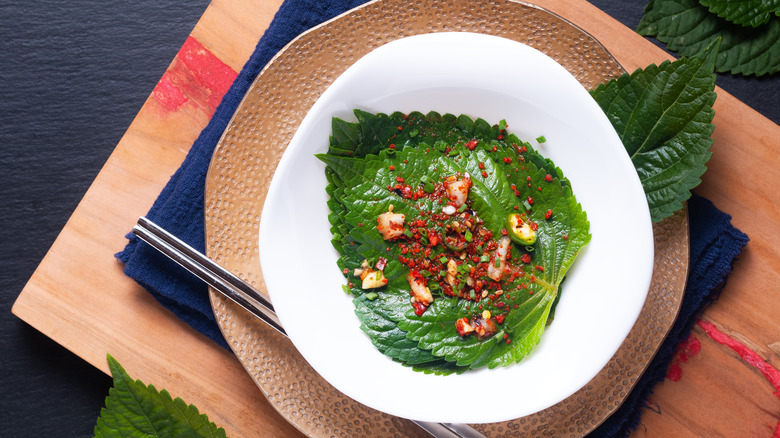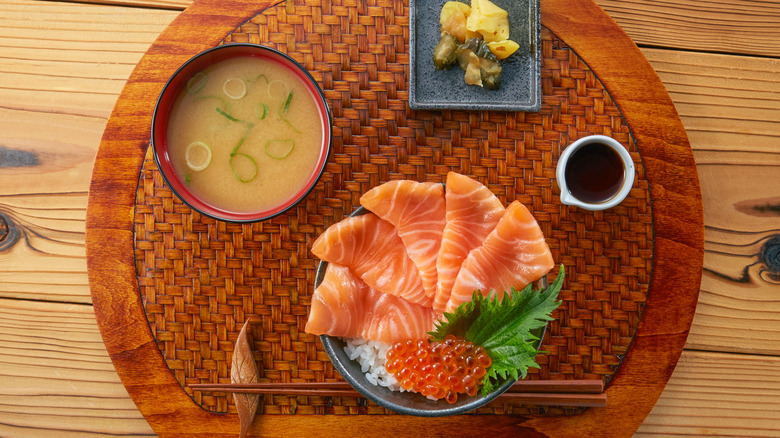What Is Shiso Leaf And What Does It Taste Like?
With its vibrant color and distinctive flavor, shiso can be a fantastic addition to sushi, tofu, gazpacho, noodles, and salads. This aromatic herb is also known as perilla leaf, Japanese basil, or beefsteak plant and comes from Perilla frutescens, a plant related to mint. Most varieties are green or red-purple, adding a splash of color to the plate.
Shiso leaves have been used in Southeast Asian cuisine for centuries. The red variety is a key ingredient in umeboshi, or pickled plums, whereas green shiso goes well with tempura, meat, rice, noodles, and other dishes. Some Asian stores also sell ruffled green or red shiso, variegated shiso, or bicolor shiso, and each variety has a unique flavor and scent. For example, green shiso leaves are slightly bitter with citrusy notes. Red shiso is more bitter and astringent, and its flavor can overpower other ingredients. But even so, you can use it as a garnish or cook it to tame its flavor.
This herb can replace basil, cilantro, or mint in most recipes. For starters, try this shiso mojito recipe, add perilla to scrambled eggs, or pickle it with cucumbers. You can also chop and mix the leaves into sauces or fry them in tempura batter to spice up your meals.
Shiso, the minty herb that will surprise your senses
Shiso is a staple of Japanese cuisine, offering both flavor and nutrition. Centuries ago, Chinese people used it as a natural remedy for food poisoning, notes a 2013 review published in Evidence-Based Complementary and Alternative Medicine. Modern research shows it may help relieve allergies, suppress inflammation, and boost mental health, among other benefits. Plus, it's rich in volatile oils, rosmarinic acid, and other chemicals with antioxidant, antidepressant, and anti-cancer properties. But what makes it stand out is its unique flavor.
This perennial herb boasts a slightly sweet, herbaceous taste with notes of mint, anise, basil, and cinnamon. Its flavor is both earthy and fresh, making it suitable for a wide range of dishes. "I find it overpowering," Swiss chef Gray Kunz said to The New York Times. "You have to get used to it," he added. "It is not a versatile herb, but in certain settings, it is just fantastic, and in the tuna, it does exactly what I want it to do," chef Alfred Portale told the outlet.
Shiso leaves vary in flavor, depending on their type and composition. For example, Vietnamese perilla has a stronger aroma than Japanese or Korean varieties. Green shiso boasts a milder flavor than red shiso leaves and can be consumed raw. With its fragrant taste, it's ideal for when you want to make sushi for your brunch or dinner party. Red shiso, on the other hand, is better suited for cooked dishes.
How to use shiso in your recipes
This aromatic herb goes well in both sweet and savory dishes, as well as in spirits, cocktails, and flavored oils. If, say, you want to make herb-infused oil at home, you can use shiso alone or pair it with thyme, rosemary, parsley, and other herbs. Shiso leaves are also a great addition to fruit or vegetable salads, marinades, broths, and fish dishes.
Another option is to use them as a wrap or garnish for sushi rolls and sashimi. Simply lay the rice on a shiso leaf, add salmon, tuna, or other ingredients, and roll up the sushi. Similarly, you can wrap fish or meat in shiso leaves before grilling or frying them. However, this technique requires some practice, says cookbook author Elizabeth Andoh. "Unless you are very skilled at cooking with shiso, it turns black and becomes bitter when it is heated," she told The New York Times.
Last but not least, consider using shiso in homemade spirits, fruit juices, liquors, lemonade, tea, and other beverages. A good example is Aka Shiso, a Japanese drink made with red shiso leaves, sugar, sparkling water, and apple cider vinegar. "The bright herbal flavor the shiso leaf lends is very complimentary to tart citrus flavors like lemon, lime, and passion fruit," bartender Justin Park said to Imbibe.


